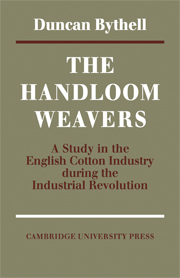Book contents
- Frontmatter
- Contents
- Preface
- Introduction
- Map of the weaving towns and villages of north-east Lancashire in 1821
- 1 Problems and sources
- 2 The organization of the industry
- 3 The labour force
- 4 The coming of the powerloom
- 5 Wages: (I) The piece-rate
- 6 Wages: (II) Earnings and the standard of living
- 7 Public opinion and the handloom weavers
- 8 Organized industrial action among the cotton handloom weavers
- 9 The weavers and radical politics
- 10 The problem of poverty
- 11 Displacement and disappearance
- Appendix 1 Some piece-rate series
- Appendix 2 The piece-rate and the price of food
- Appendix 3 G. H. Wood's estimates of average weekly earnings
- Bibliography
- Index
Appendix 2 - The piece-rate and the price of food
Published online by Cambridge University Press: 07 October 2011
- Frontmatter
- Contents
- Preface
- Introduction
- Map of the weaving towns and villages of north-east Lancashire in 1821
- 1 Problems and sources
- 2 The organization of the industry
- 3 The labour force
- 4 The coming of the powerloom
- 5 Wages: (I) The piece-rate
- 6 Wages: (II) Earnings and the standard of living
- 7 Public opinion and the handloom weavers
- 8 Organized industrial action among the cotton handloom weavers
- 9 The weavers and radical politics
- 10 The problem of poverty
- 11 Displacement and disappearance
- Appendix 1 Some piece-rate series
- Appendix 2 The piece-rate and the price of food
- Appendix 3 G. H. Wood's estimates of average weekly earnings
- Bibliography
- Index
Summary
Fluctuations in the piece-rates paid for cotton weaving were far wider than changes in the price of food, and the long-term drop in piece-rates in the post-1815 period was far sharper than the fall in the cost of living. Sufficient materials to construct a reliable cost of living index for this period are not available. But enough is known about the retail price of particular commodities, such as oatmeal, which was a staple element in the weavers' diet, to enable a useful comparison to be made between piece-rates and food prices. Although this cannot provide an exact summary of the widely different progresses of wages and of the cost of living in this crucial phase of the industrial revolution, a comparison based on these materials can serve the same general function as Professor Rostow's famous ‘social tension’ chart, by indicating when the weavers' distress was most acute. The indices for the piece-rate and the retail price of oatmeal are closest in 1821–2, which are years of notable calm; and they are furthest apart in 1817, 1826, and 1829, years of known distress and disturbance.
The index for oatmeal has been constructed from four sources, three in the parliamentary papers of the early 1830s, the fourth, covering only the first few years, in the Manchester Mercury of 18 January 1819.
- Type
- Chapter
- Information
- The Handloom Weavers , pp. 277 - 279Publisher: Cambridge University PressPrint publication year: 1969

